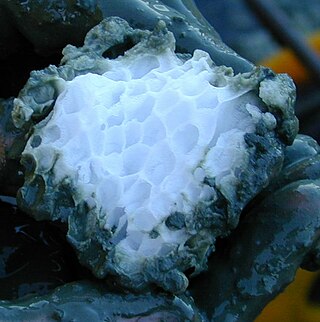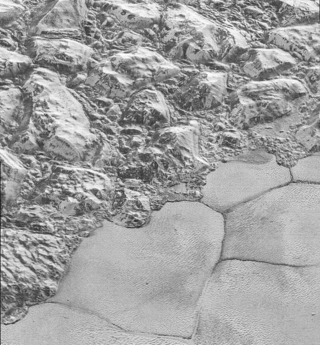Related Research Articles

Methane clathrate (CH4·5.75H2O) or (8CH4·46H2O), also called methane hydrate, hydromethane, methane ice, fire ice, natural gas hydrate, or gas hydrate, is a solid clathrate compound (more specifically, a clathrate hydrate) in which a large amount of methane is trapped within a crystal structure of water, forming a solid similar to ice. Originally thought to occur only in the outer regions of the Solar System, where temperatures are low and water ice is common, significant deposits of methane clathrate have been found under sediments on the ocean floors of the Earth. Methane hydrate is formed when hydrogen-bonded water and methane gas come into contact at high pressures and low temperatures in oceans.

Clathrate hydrates, or gas hydrates, clathrates, hydrates, etc., are crystalline water-based solids physically resembling ice, in which small non-polar molecules or polar molecules with large hydrophobic moieties are trapped inside "cages" of hydrogen bonded, frozen water molecules. In other words, clathrate hydrates are clathrate compounds in which the host molecule is water and the guest molecule is typically a gas or liquid. Without the support of the trapped molecules, the lattice structure of hydrate clathrates would collapse into conventional ice crystal structure or liquid water. Most low molecular weight gases, including O2, H2, N2, CO2, CH4, H2S, Ar, Kr, and Xe, as well as some higher hydrocarbons and freons, will form hydrates at suitable temperatures and pressures. Clathrate hydrates are not officially chemical compounds, as the enclathrated guest molecules are never bonded to the lattice. The formation and decomposition of clathrate hydrates are first order phase transitions, not chemical reactions. Their detailed formation and decomposition mechanisms on a molecular level are still not well understood. Clathrate hydrates were first documented in 1810 by Sir Humphry Davy who found that water was a primary component of what was earlier thought to be solidified chlorine.
In chemistry, a hydrate is a substance that contains water or its constituent elements. The chemical state of the water varies widely between different classes of hydrates, some of which were so labeled before their chemical structure was understood.
In chemistry, noble gas compounds are chemical compounds that include an element from the noble gases, group 18 of the periodic table. Although the noble gases are generally unreactive elements, many such compounds have been observed, particularly involving the element xenon.

A clathrate is a chemical substance consisting of a lattice that traps or contains molecules. The word clathrate is derived from the Latin clathratus, meaning ‘with bars, latticed’. Most clathrate compounds are polymeric and completely envelop the guest molecule, but in modern usage clathrates also include host–guest complexes and inclusion compounds. According to IUPAC, clathrates are inclusion compounds "in which the guest molecule is in a cage formed by the host molecule or by a lattice of host molecules." The term refers to many molecular hosts, including calixarenes and cyclodextrins and even some inorganic polymers such as zeolites.
Carbon dioxide hydrate or carbon dioxide clathrate is a snow-like crystalline substance composed of water ice and carbon dioxide. It normally is a Type I gas clathrate. There has also been some experimental evidence for the development of a metastable Type II phase at a temperature near the ice melting point. The clathrate can exist below 283K (10 °C) at a range of pressures of carbon dioxide. CO2 hydrates are widely studied around the world due to their promising prospects of carbon dioxide capture from flue gas and fuel gas streams relevant to post-combustion and pre-combustion capture. It is also quite likely to be important on Mars due to the presence of carbon dioxide and ice at low temperatures.

Ho-Kwang (Dave) Mao is a Chinese-American geologist. He is the director of the Center for High Pressure Science and Technology Advanced Research in Shanghai, China. He was a staff scientist at Geophysical Laboratory of the Carnegie Institution for Science for more than 30 years. Mao is a recognized leading scientist in high pressure geosciences and physical science. There are two minerals named after him, Davemaoite and Maohokite.

The element sulfur exists as many allotropes. In number of allotropes, sulfur is second only to carbon. In addition to the allotropes, each allotrope often exists in polymorphs delineated by Greek prefixes.

Methane is a chemical compound with the chemical formula CH4. It is a group-14 hydride, the simplest alkane, and the main constituent of natural gas. The relative abundance of methane on Earth makes it an economically attractive fuel, although capturing and storing it poses technical challenges due to its gaseous state under normal conditions for temperature and pressure.
Solid hydrogen is the solid state of the element hydrogen, achieved by decreasing the temperature below hydrogen's melting point of 14.01 K. It was collected for the first time by James Dewar in 1899 and published with the title "Sur la solidification de l'hydrogène" in the Annales de Chimie et de Physique, 7th series, vol. 18, Oct. 1899. Solid hydrogen has a density of 0.086 g/cm3 making it one of the lowest-density solids.
A Bjerrum defect is a crystallographic defect which is specific to ice, and which is partly responsible for the electrical properties of ice. It was first proposed by Niels Bjerrum in 1952 in order to explain the electrical polarization of ice in an electric field. A hydrogen bond normally has one proton, but a hydrogen bond with a Bjerrum defect will have either two protons or no proton. D-defects are more energetically favorable than L-defects. The unfavorable defect strain is resolved when a water molecule pivots about an oxygen atom to produce hydrogen bonds with single protons. Dislocations of ice Ih along a slip plane create pairs of Bjerrum defects, one D defect and one L defect.
Helium is the smallest and the lightest noble gas and one of the most unreactive elements, so it was commonly considered that helium compounds cannot exist at all, or at least under normal conditions. Helium's first ionization energy of 24.57 eV is the highest of any element. Helium has a complete shell of electrons, and in this form the atom does not readily accept any extra electrons nor join with anything to make covalent compounds. The electron affinity is 0.080 eV, which is very close to zero. The helium atom is small with the radius of the outer electron shell at 0.29 Å. Helium is a very hard atom with a Pearson hardness of 12.3 eV. It has the lowest polarizability of any kind of atom, however, very weak van der Waals forces exist between helium and other atoms. This force may exceed repulsive forces, so at extremely low temperatures helium may form van der Waals molecules. Helium has the lowest boiling point of any known substance.

Solid nitrogen is a number of solid forms of the element nitrogen, first observed in 1884. Solid nitrogen is mainly the subject of academic research, but low-temperature, low-pressure solid nitrogen is a substantial component of bodies in the outer Solar System and high-temperature, high-pressure solid nitrogen is a powerful explosive, with higher energy density than any other non-nuclear material.
Nitrogen clathrate or nitrogen hydrate is a clathrate consisting of ice with regular crystalline cavities that contain nitrogen molecules. Nitrogen clathrate is a variety of air hydrates. It occurs naturally in ice caps on Earth, and is believed to be important in the outer Solar System on moons such as Titan and Triton which have a cold nitrogen atmosphere.
Neon compounds are chemical compounds containing the element neon (Ne) with other molecules or elements from the periodic table. Compounds of the noble gas neon were believed not to exist, but there are now known to be molecular ions containing neon, as well as temporary excited neon-containing molecules called excimers. Several neutral neon molecules have also been predicted to be stable, but are yet to be discovered in nature. Neon has been shown to crystallize with other substances and form clathrates or Van der Waals solids.
Russell Julian Hemley is an American geophysicist, solid-state physicist, and physical chemist.
A polyhydride or superhydride is a compound that contains an abnormally large amount of hydrogen. This can be described as high hydrogen stoichiometry. Examples include iron pentahydride FeH5, LiH6, and LiH7. By contrast, the more well known lithium hydride only has one hydrogen atom.
Metallization pressure is the pressure required for a non-metallic chemical element to become a metal. Every material is predicted to turn into a metal if the pressure is high enough, and temperature low enough. Neon has the highest metallization pressure for any element.

Wendy Li-Wen Mao is an American geologist who is a professor at SLAC National Accelerator Laboratory. Her research considers the mineral physics of planetary interiors, new materials under extreme environments and novel characterisation techniques. In 2021 she was elected Fellow of the European Association of Geochemistry.

Ice XVII is a metastable form of ice with a hexagonal structure and helical channels that was discovered in 2016. It can be formed by freezing water with hydrogen molecules at high pressure to form a filled ice, and then removing the hydrogen molecules from the structure. The form has potential for being used in hydrogen storage. Ice XVII made from heavy water can also be reduced to pure cubic ice.
References
- ↑ Hirscher, Michael (4 August 2010). "Clathrate Hydrates". Chapter 3. Clathrate Hydrates. Handbook of Hydrogen Storage. Wiley. pp. 63–79. doi:10.1002/9783527629800.ch3. ISBN 9783527629800.
- ↑ Sabo, Dubravko; Sabo, Dubravko; Clawson, Jacalyn; Rempe, Susan; Greathouse, Jeffery; Martin, Marcus; Leung, Kevin; Varma, Sameer; Cygan, Randall; Alam, Todd (7 March 2007). "Hydrogen clathrate hydrates as a potential hydrogen storage material". MAR07 Meeting of the American Physical Society. 52 (1): S39.012. Bibcode:2007APS..MARS39012S . Retrieved 10 September 2011.
- ↑ Veluswamy, Hari Prakash; Kumar, Rajnish; Linga, Praveen (2014). "Hydrogen storage in clathrate hydrates: Current state of the art and future directions". Applied Energy. 122: 112–132. doi:10.1016/j.apenergy.2014.01.063.
- 1 2 3 Lokshin, Konstantin A.; Yusheng Zhao; Duanwei He; Wendy L. Mao; Ho-Kwang Mao; Russell J. Hemley; Maxim V. Lobanov & Martha Greenblatt (14 September 2004). "Structure and Dynamics of Hydrogen Molecules in the Novel Clathrate Hydrate by High Pressure Neutron Diffraction". Physical Review Letters. 93 (12): 125503–1–125503–4. Bibcode:2004PhRvL..93l5503L. doi:10.1103/PhysRevLett.93.125503. PMID 15447276.
- ↑ Mao, Wendy L.; Mao, A. F. Goncharov; V. V. Struzhkin; Q. Guo; J. Hu, J. Shu; R. J. Hemley; M Somayazulu & Y. Zhao (2002). "Hydrogen Clusters in Clathratehydrate". Science. 297 (5590): 2247–2249. Bibcode:2002Sci...297.2247M. doi:10.1126/science.1075394. PMID 12351785. S2CID 24168225.
- ↑ Vos, Willem L.; Finger, Larry W.; Hemley, Russell J.; Mao, Ho-kwang (August 1996). "Pressure dependence of hydrogen bonding in a novel H2O-H2 clathrate". Chemical Physics Letters. 257 (5–6): 524–530. Bibcode:1996CPL...257..524V. doi:10.1016/0009-2614(96)00583-0.
- ↑ Qian, Guang-Rui; Lyakhov, Andriy O.; Zhu, Qiang; Oganov, Artem R.; Dong, Xiao (8 July 2014). "Novel Hydrogen Hydrate Structures under Pressure". Scientific Reports. 4: 5606. Bibcode:2014NatSR...4E5606Q. doi:10.1038/srep05606. PMC 4085642 . PMID 25001502.
- 1 2 Struzhkin, Viktor; Burkhard Militzer; Wendy L. Mao; Ho-kwang Mao & Russell J. Hemley (7 December 2006). "Hydrogen Storage in Molecular Clathrates" (PDF). Chem Rev. 107 (10): 4133–4151. doi:10.1021/cr050183d. PMID 17850164.
- ↑ Smirnov, G. S.; Stegailov, V. V. (17 December 2015). "Anomalous diffusion of guest molecules in hydrogen gas hydrates". High Temperature. 53 (6): 829–836. doi:10.1134/S0018151X15060188. S2CID 123843390.
- ↑ Lunine, Jonathan I.; Stevenson, David J. (1985). "Thermodynamics of clathrate hydrate at low and high pressures with application to the outer solar system". The Astrophysical Journal Supplement Series. 58: 493. Bibcode:1985ApJS...58..493L. doi:10.1086/191050 . Retrieved 10 September 2011.